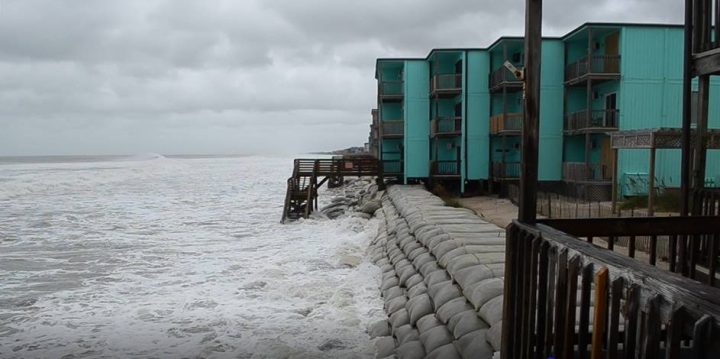
SNEADS FERRY – With each post-hurricane recovery there are at least a couple of things that are a given – there are some things to be learned and some things will remain the same.
Left in the wake of Hurricane Florence in Topsail Island’s three towns are mangled and destroyed public walkways and dunes, shoreline erosion, the fields of debris washed ashore that had to be collected and carted away, hundreds of damaged homes and lost revenue from rental closures.
Supporter Spotlight
It adds up to a hefty price tag, one the Topsail Island Shoreline Protection Commission is collectively working to recoup at least some of which from the Federal Emergency Management Agency, or FEMA.
“One of the things is to remember,” said Spencer Rogers. “You’ve dealt with this before. You can do it again.”
The coastal engineering expert with North Carolina Sea Grant spoke at a commission meeting last week in North Topsail Beach’s temporary town hall at the end of a small strip mall off N.C. 172 in Sneads Ferry.
He reminded commission members and a small audience at last Thursday’s meeting that the island has, in the last 25 years, recovered from the likes of Hurricane Fran – a Category 3 storm that in 1996 damaged three-quarters of the structures on the island and destroyed more than 300 homes.
Three years later, Hurricane Floyd, a Category 2 hurricane, dumped nearly 20 inches of rain in some areas of North Carolina, causing catastrophic flooding inland.
Supporter Spotlight
An average of more than 17.5 inches of rain fell over North Carolina from Hurricane Florence.
Rain, winds and waves sliced Topsail Island’s nearly 30-mile-long shoreline, breaching and scarping dunes.
Rogers advised allowing nature to play out and allow scarped dunes to dry out and collapse.
“That’s something you’re going to see,” he said. “There’s a lot of it out there. Don’t panic. Don’t think that’s necessarily a bad thing.”
When an escarped dune topples naturally, vegetation on the top of the dune will fall with the collapsed sand. This allows the vegetation to stabilize at the dune’s base and grow, fortifying the dune.
Pushing sand from the beach berm back to a damaged dune line isn’t necessarily the best idea, Rogers said.
“The farther landward you can build your dunes the more protection you’ll get out of it.”
Spencer Rogers, North Carolina Sea Grant
He referred to a study that showed dunes recovered after sand was pushed against them from a seaward location and will grow toward the ocean. That seaward-growing movement places the base of the dune closer to the ocean, making it even more susceptible to wave damage during a storm.
“The farther landward you can build your dunes the more protection you’ll get out of it,” Rogers said.
Sand ripped from the dunes during the storm will likely wash back ashore as time passes. How much of that sand the ocean will return is uncertain, but, there have been cases following some storms in which 100 percent of the sand was transported back onto the beach, Rogers said.
He also advised the commission, whose members include elected officials from each of the island’s towns as well as representatives from Onslow and Pender counties, to plan for better vehicle access ramps onto the beach.
Low, flat vehicle access areas allow water to easily wash through the dune line, pushing flood water and heaps of sand onto beach roads and into private yards.
Rogers said the best rule of thumb is to build vehicle access ramps at the same elevation as public accesses to the beach – no lower than 3 feet from the dunes around it.
Overall, Rogers suggested the towns look at ways to most efficiently use hurricane recovery funds.
“What you’ve got to do is convince (FEMA) you’ve got a better way to spend their money,” he said.
Town officials know the wait for any federal reimbursement for storm damage could be lengthy. They’re aware they may have to push harder to retrieve money as disaster-declared areas of Florida, where parts of the western panhandle were obliterated by Hurricane Michael earlier this month, continue its long road to recovery.
“The impacts are great, and the process is slow,” said Topsail Beach Town Manager Mike Rose.
“The impacts are great, and the process is slow.”
Mike Rose, Topsail Beach town manager
He said that Topsail Beach is “closer” to receiving a permit for its next beach re-nourishment project, originally planned for November 2019. Town officials will discuss what options they have, including whether to try to push the project before the fall of next year.
“It at least opens up the possibility of options as we go through,” Rose said.
Both Surf City and North Topsail Beach were forced to move their town hall operations to temporary facilities after the storm.
Surf City’s town hall has been condemned and town officials are in the process of looking for a new location, said Town Manager Ashley Loftis.
Hauling equipment has been moved onto the beach and crews have begun loading and hauling debris. They are beginning at the north end of town and moving south toward the pier. A staging site will be located at… https://t.co/1osoy6cixz
— Town of Surf City (@SurfCityTourism) October 30, 2018
Sand continues to be sifted off private properties and placed back on the beach, she said, and only a handful of beach accesses are open. Piles of debris gathered after the storm on the town’s shoreline will be removed by Nov. 9.
North Topsail’s town hall, located near the foot of the causeway that connects the island’s north end to the mainland, will cost an estimated $500,000 to upwards of $1 million in repairs, Town Manager Bryan Chadwick said.
More than 850 structures received minor damage from the storm and nearly 80 sustained heavy damage, he said. A debris-removal company has hauled away about 64,000 cubic yards of storm-related refuse.
The town is looking at about $15 million to $20 million in dune repairs.
North Topsail’s Mayor Dan Tuman suggested including the topic of sea walls as possible options to future beach armament.
He referred to the town’s permitted sandbag revetment, a super-sized wall of sandbags some 45 feet wide and 20 feet tall, to stave off chronic erosion at New River Inlet. The bags are permitted through 2022.
“Our dunes really took a beating,” he said. “One thing that didn’t take a beating was our sandbag revetment. It did just fine.”









